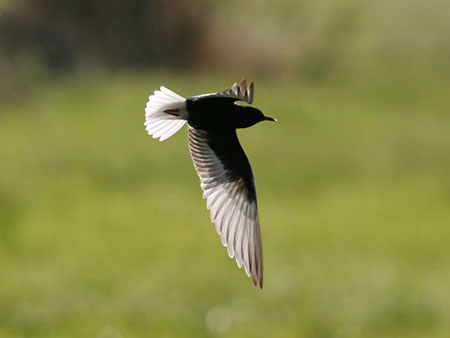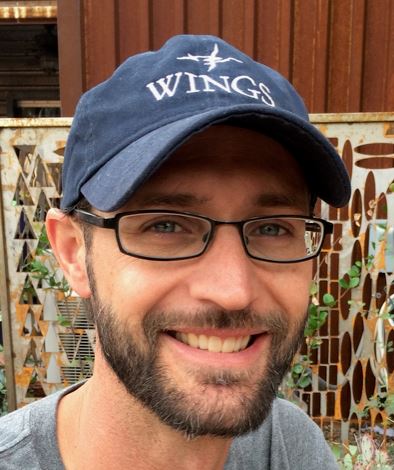
Elegant White-winged Terns dot eastern Poland’s marshes Photo: Stuart Elsom
Birding in Eastern Poland in late May is magical. Every mile of road has at least one pair of White Storks nesting on top of a roadside telegraph pole, the incessant crex crex call of Corncrakes, and Common Cuckoos seem to be in every patch of woodland or reed. The general area hosts a range of habitats, from the extensive Biebrza Marshes – home to a significant proportion of the world’s breeding Aquatic Warblers – to the primeval Bialowieza Forest. Accordingly, a wide variety of species can be encountered, many in numbers seldom found elsewhere in Europe.
Day 1: The tour begins this evening in Warsaw, Poland. Night in Warsaw.
Days 2-4: We’ll leave Warsaw travelling northeast towards the city of Bialystok and Biebrza National Park (Bialowieza Park Narodowy). We’ll make several stops on route, including for one of Europe’s fastest declining species, Ortolan Bunting. Our first glimpses of the extensive marsh complexes might reveal our first White-winged Tern, and we’ll keep an eye out for White-tailed, Lesser Spotted and Greater Spotted Eagles.
Polish dinners tend to be served relatively early, opening up the evening for birding…and it’s a great time to visit the marshes We’ll go to a site that, in some years, holds a Great Snipe lek, although the site has become overgrown in recent years. Even if the snipe are not present when we visit, the evening is sure to be memorable, with multiple Eurasian Woodcocks ‘roding’ over the surrounding woodland, and a host of ‘night singers’, including Thrush Nightingale, Grasshopper Warbler and Tawny Owl.
As we may have been up late last night, we’ll have a relaxed start to day 3. We’ll visit an accessible area of marshland close to the hotel that holds breeding Aquatic Warbler, and explore a nearby nature reserve where we’ll look for Savi’s Warbler, Penduline Tit and, if we’re lucky, Little Crake or a Great Grey Shrike. We’ll finish the morning with a drive along the famous (and bumpy!) Tsar’s Road, which runs along the spine of the national park, in search of woodland species, such as Icterine and Wood Warblers, Red-breasted Flycatcher and Hawfinch.
After lunch, we’ll explore an area of flooded meadow that, in most years, holds breeding White-winged and Whiskered Terns. Depending on which area of the meadow they’re nesting in, views can be as close as a few tens of yards as they hawk for insects by the side of the road. As evening arrives, we’ll follow a short boardwalk that runs out into the marshes. This is another good site for Aquatic Warbler, and Short-eared Owls are occasionally seen. Our last stop will be at a nearby observation tower, where Moose are sometimes observed feeding in the wet meadows.
On ourfinal morning in the marshes, we’ll follow a flexible schedule. If we haven’t seen Aquatic Warbler, we can make the 4-mile round trip walk to an area in the center of the marsh that holds the highest densities of the species. If we’ve already seen the warbler, we can investigate areas of woodland or patches of farmland to look for other species we are missing. In the afternoon, we’ll explore the central area of the river valley, where we’ll hope to see Ruff, Wood Sandpiper, Bluethroat, Citrine Wagtail, and perhaps Eurasian Bittern. It provides as well another opportunity to see Moose. Nights in Grajewo.
Day 5: We’ll spend the day travelling southwest towards the Bialowieza Forest, with birding en route. We’ll be alert for birds of agricultural land, such as Grey Partridge and Corn Bunting, and, depending on water levels, we may visit some lagoons to look for waterfowl and shorebirds. If time permits, we’ll do some birding around Bialowieza village. Night in Bialowieza village.
Day 6: We’ll begin on the edge of Bialowieza Forest Reserve, where we’ll hope to see a variety of woodpeckers including Great Spotted, Lesser Spotted, Black, Grey-headed, White-backed and, if we’re extremely lucky, the elusive Three-toed. The forest edges hold Golden Oriole, Common Rosefinch and perhaps River Warbler.
After lunch, we’ll visit the grounds of the Bialowieza forest park, where we can expect to see Middle Spotted Woodpecker and Wryneck, as well as other open-parkland species including the stunning black-and-white Collared Flycatcher, Serin and Tree Pipit, while the park lake holds Great Reed Warbler. The area north of the park is a good area to look for one of Europe’s most endangered mammals, the European Bison. Night in Bialowieza village.
Day 7: We’ll spend our final morning birding in the area west of Bialowieza Forest, where we’ll hope to find open-terrain species such as Red-backed Shrike as well as further chances of scarce species such as River Warbler and Three-toed Woodpecker. We’ll also visit a site where Eurasian Pygmy Owl resident if not always seen, and if time permits, we’ll visit another site to look for European Bison. After lunch, we’ll drive to Warsaw. Night in Warsaw.
Day 8: The tour concludes this morning in Warsaw.
Updated: 04 June 2024
Prices
- 2025 Tour Price : $2,650
- Single Occupancy Supplement : $360
Notes

Questions? Tour Manager: Matt Brooks. Call 1-866-547-9868 (US or Canada) or (01) 520-320-9868 or click here to email.
* Tour invoices paid by check carry a 4% discount. Details here.
This tour is limited to 7 participants with one leader.
